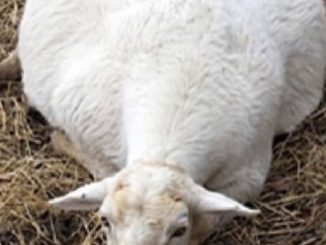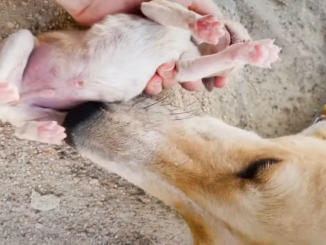Once upon a time in the picturesque village of Düzpelit, nestled in the snow-covered landscapes of Ordu, Turkey, a dedicated veterinarian named Ogün Öztürk found himself on a unique mission. He had been summoned to the village to attend to a sick cow, a task he expected to complete swiftly and return home. Little did he know that this visit would lead to an unexpected and heartwarming connection.

As Ogün wrapped up his work with the ailing cow, he noticed something out of the ordinary. Through the thick blankets of snow, he spotted a determined little girl trudging towards him, carrying a pup on her back. Their extraordinary friendship began at that very moment.

The courageous girl was none other than Cemre Su Türköz, a resident of the village. Her faithful companion, Pamuk, had been suffering from an incessant itch for several days. Worried about her furry friend’s health, Cemre was determined to find a veterinarian as soon as possible. However, heavy snowfall had cut off access to the district center, leaving her with no choice but to explore alternative options. As luck would have it, an opportunity presented itself.

That fateful day, Cemre heard that a veterinarian would be in town to tend to a cow. Fearing that the vet might leave the village before she could seek his help, Cemre Su placed Pamuk on her back and embarked on a journey of over a mile along treacherous snow-covered mountain roads to reach Ogün’s location. Her arrival took the vet completely by surprise.

The resolute young girl approached Ogün and explained her predicament – her dog’s persistent itch, the inability to reach the district center due to the snow, and her desperation to have Pamuk examined. Who could refuse such an astonishing and determined client? Without hesitation, Ogün conducted a thorough examination, and fortunately, Pamuk’s condition was not dire. A simple topical medication would suffice to alleviate his discomfort.

In awe of the 8-year-old’s courage, Ogün refused to accept any payment for his services. Cemre offered approximately 7 liras, but he kindly declined. The kindness and bravery displayed by Cemre were rewards beyond measure for the compassionate vet.

This encounter marked the beginning of a beautiful friendship. Ogün continued to visit the village, not only to check on Pamuk’s well-being but also to spend time with Cemre and her beloved dog. Through the harshest of weather conditions, Pamuk felt the love and care that the little girl had showered upon him. It was a heartwarming tale of friendship and the boundless love between a little girl and her loyal canine companion.
“Soulful Harmony: An Emotionally Stirring Saga of Unconditional Love as Mother Dog and Pup Weave a Tale of Resilience – Together, They Unveil a New Chapter of Hope.

Nestled in a quaint suburban haven, the enchanting tale of Max and Bella unfolded—a narrative of canine camaraderie that enchanted all who encountered it. Max, the vivacious Golden Retriever, and Bella, the tender-hearted Labrador, dwelled in neighboring abodes, sharing not just a neighborhood but a profound connection that transcended the limitations of language.
Their days were an exquisite symphony of joy and play in the nearby park, where their delightful interactions spoke a language beyond words. Max’s exuberance harmonized perfectly with Bella’s gentle nature, creating a companionship where understanding flowed effortlessly, as if they possessed an innate knowledge of each other’s thoughts and emotions.

Yet, like all narratives, their story bore moments of trials. Max’s enthusiasm once sent a vase crashing, while Bella’s curiosity left a cherished pair of shoes in disarray. The echoes of their owners’ disapproval resonated, casting a temporary shadow. In these moments, Max and Bella sought solace in each other’s silent assurance—a reassurance that their bond transcended human reproach.
United as a team, they embarked on a journey of mutual growth. Through shared experiences and challenges, they imparted virtues of patience, empathy, and perseverance to one another. Bella’s calm demeanor inspired Max to approach life with understanding, while Max’s zeal encouraged Bella to step beyond her comfort zone. In their companionship, they learned that worth was not defined by mistakes but by unwavering support and resilience.

A joyous reunion with their owners solidified the profound bond between Max and Bella, serving as a beacon of devotion and loyalty. Their companionship became a symbol of forgiveness, strength, and enduring love, spreading across the globe through viral videos. Max and Bella’s story resonated with people, depicting two dogs finding strength and solace in each other after being scolded and sidelined.
“Strength in Togetherness” wasn’t just a story; it embodied the transformative power of friendship. Max and Bella’s journey showcased how unwavering support and an unbreakable spirit could foster growth amidst adversity. Their narrative stands as a testament to the resilience of the human (and canine) spirit, inspiring others to weather challenges and cultivate enduring connections.




Leave a Reply